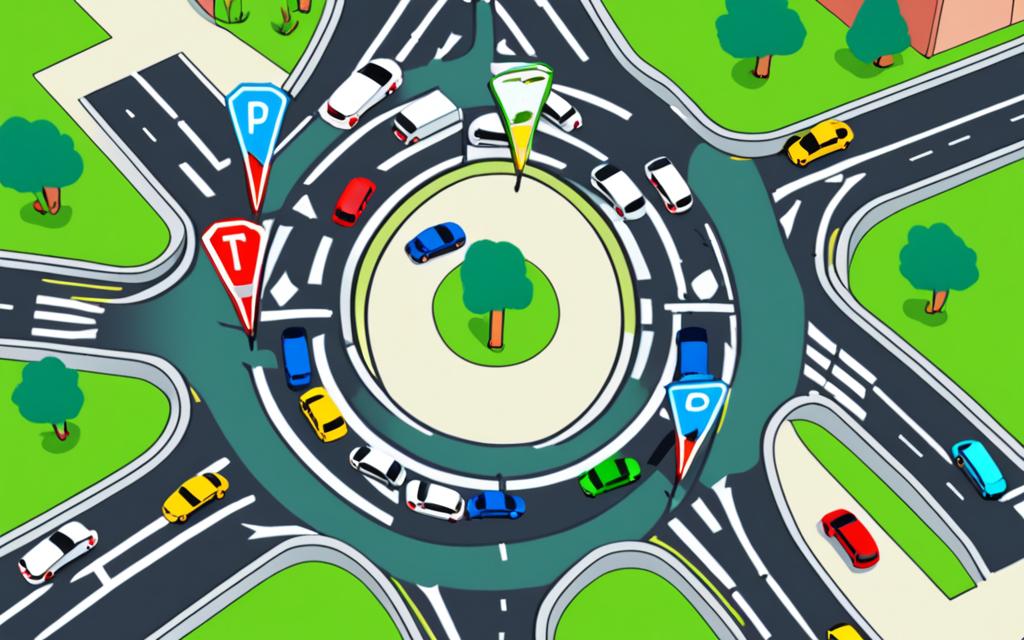Complete Roundabout Navigation Guide: Master Traffic Circles Safely
Published on
Roundabouts are becoming increasingly common throughout Ontario, including Windsor, and they can be intimidating for new drivers. However, with proper understanding and practice, navigating roundabouts becomes second nature. At Rajput Driving School, we've helped hundreds of students master roundabout navigation, and this comprehensive guide will teach you everything you need to know about safely and confidently navigating these traffic circles.

What is a Roundabout?
A roundabout is a circular intersection where traffic flows counterclockwise around a central island. Unlike traditional intersections with traffic lights or stop signs, roundabouts use yield signs to control traffic flow. This design promotes continuous traffic movement and reduces the severity of accidents compared to conventional intersections.
Key Benefits of Roundabouts:
- Improved Safety: Reduces severe accidents by 78% compared to traditional intersections
- Better Traffic Flow: Continuous movement reduces congestion and delays
- Environmental Benefits: Less idling means reduced emissions and fuel consumption
- Lower Maintenance: No traffic signals to maintain or repair
Understanding Roundabout Components
Essential Elements:
- Central Island: The raised circular area in the center that vehicles drive around
- Circulatory Roadway: The curved road that vehicles travel on around the central island
- Splitter Islands: Raised areas that separate entering and exiting traffic
- Yield Line: The point where entering vehicles must yield to circulating traffic
- Exit Points: The locations where vehicles leave the roundabout
Step-by-Step Roundabout Navigation
1. Approach the Roundabout
As you approach a roundabout, follow these steps:
- Reduce Speed: Slow down to 15-20 km/h as you approach
- Choose Your Lane:
- Right lane: For turning right or going straight
- Left lane: For turning left or going straight (if available)
- Watch for Pedestrians: Check crosswalks for pedestrians before entering
- Read Signs: Look for directional signs indicating which exits lead where
2. Enter the Roundabout
This is the most critical step in roundabout navigation:
- Yield to Circulating Traffic: Always yield to vehicles already in the roundabout
- Look Left: Check for vehicles approaching from your left
- Wait for a Gap: Only enter when you have a safe opportunity
- Enter When Safe: Proceed into the roundabout when the way is clear
3. Navigate the Roundabout
Once inside the roundabout:
- Stay in Your Lane: Maintain your position within your chosen lane
- Keep Moving: Don't stop inside the roundabout unless absolutely necessary
- Signal Your Exit: Use your right turn signal before your intended exit
- Watch for Other Vehicles: Be aware of vehicles changing lanes or exiting
4. Exit the Roundabout
To exit safely:
- Signal Right: Turn on your right signal before your exit
- Check for Pedestrians: Look for pedestrians in the crosswalk
- Exit Smoothly: Make a smooth right turn to exit
- Turn Off Signal: Turn off your signal once you've exited
Different Types of Roundabouts
Single-Lane Roundabouts
These are the most common type in residential areas and smaller intersections:
- Only one lane of traffic circulates around the central island
- Easier to navigate for new drivers
- All vehicles follow the same path
- No lane changes required once inside
Multi-Lane Roundabouts
These handle higher traffic volumes and are found on major roads:
- Two or more lanes circulate around the central island
- Require careful lane selection before entering
- May have different exit points for different lanes
- Allow lane changes within the roundabout (if safe)
Mini Roundabouts
Smaller versions often found in residential neighborhoods:
- Smaller central island, sometimes just painted markings
- Lower speed limits (typically 15-25 km/h)
- Often used to calm traffic in residential areas
- Same navigation rules apply, but at slower speeds
Common Roundabout Scenarios
Scenario 1: Turning Right (First Exit)
When taking the first exit (turning right):
- Stay in the right lane as you approach
- Signal right before entering
- Yield to circulating traffic
- Enter and immediately exit
Scenario 2: Going Straight (Second Exit)
When continuing straight through:
- Choose the appropriate lane (usually right lane)
- Don't signal when entering
- Yield to circulating traffic
- Signal right before your exit
Scenario 3: Turning Left (Third Exit or Beyond)
When making a left turn:
- Choose the left lane if available
- Don't signal when entering
- Yield to circulating traffic
- Navigate around the central island
- Signal right before your exit
Scenario 4: Making a U-Turn
To make a U-turn at a roundabout:
- Enter from the left lane
- Go around the entire roundabout
- Exit where you entered
- Signal right before exiting
Common Roundabout Mistakes to Avoid
Mistake 1: Stopping Inside the Roundabout
Problem: Stopping unnecessarily inside the roundabout
Solution: Only stop if there's an emergency or you're yielding to an emergency vehicle
Mistake 2: Changing Lanes Inside the Roundabout
Problem: Attempting to change lanes while circulating
Solution: Choose your lane before entering and stay in it
Mistake 3: Not Yielding to Circulating Traffic
Problem: Entering without yielding to vehicles already in the roundabout
Solution: Always yield to traffic coming from your left
Mistake 4: Signaling Too Early
Problem: Signaling right when entering instead of before exiting
Solution: Only signal right before your intended exit
Mistake 5: Driving Too Fast
Problem: Entering or circulating too quickly
Solution: Maintain appropriate speeds (15-25 km/h in most roundabouts)
Roundabout Safety Tips
For Drivers:
- Stay Alert: Always be aware of other vehicles and pedestrians
- Maintain Safe Following Distance: Don't tailgate other vehicles
- Check Blind Spots: Look for motorcycles and bicycles
- Be Patient: Wait for safe gaps rather than forcing entry
- Don't Pass: Never pass other vehicles inside a roundabout
For Pedestrians:
- Use Crosswalks: Always cross at designated pedestrian crossings
- Look Both Ways: Check for vehicles entering and exiting
- Make Eye Contact: Ensure drivers see you before crossing
- Don't Cross the Central Island: Walk around the outside
Roundabouts in Windsor and Ontario
Windsor has several roundabouts that you'll encounter during your driving experience, including:
- Parent Avenue and Wyandotte Street East: A busy roundabout near the university
- Various residential areas: Smaller roundabouts in newer subdivisions
- Highway connections: Roundabouts connecting to major highways
Ontario-Specific Rules:
- Yield to traffic already in the roundabout
- Signal your exit with a right turn signal
- Pedestrians have right-of-way at crosswalks
- Emergency vehicles have priority - pull over if safe to do so
Practice Strategies for Roundabout Mastery
Progressive Learning Approach:
- Start with Mini Roundabouts: Practice with smaller, less busy roundabouts first
- Practice During Off-Peak Hours: Learn when traffic is lighter
- Use the Same Roundabout: Master one roundabout before trying others
- Practice Different Scenarios: Try all exits from the same approach
- Build Confidence Gradually: Increase difficulty as skills improve
Mental Preparation:
- Study the Layout: Look at maps or drive by to understand the roundabout
- Plan Your Route: Know which exit you need before approaching
- Visualize Success: Mentally practice the maneuver before attempting
- Stay Calm: Don't let anxiety affect your decision-making
Advanced Roundabout Techniques
Multi-Lane Roundabouts:
For more complex roundabouts with multiple lanes:
- Lane Selection: Choose your lane based on your intended exit
- Lane Changes: Only change lanes if absolutely necessary and safe
- Exit Strategy: Position yourself in the correct lane before your exit
- Traffic Flow: Understand which lanes lead to which exits
Heavy Traffic Situations:
When roundabouts are busy:
- Be Patient: Wait for appropriate gaps rather than forcing entry
- Watch for Aggressive Drivers: Stay alert for drivers not following rules
- Maintain Position: Don't let other drivers pressure you into unsafe moves
- Plan Ahead: Consider alternative routes during peak traffic times
Roundabouts and Driving Tests
Roundabouts are often included in driving tests, so mastering them is essential for test success:
What Examiners Look For:
- Proper Yielding: Correctly yielding to circulating traffic
- Lane Selection: Choosing the appropriate lane for your intended direction
- Signaling: Using signals appropriately when exiting
- Speed Control: Maintaining appropriate speeds
- Observation: Checking for other vehicles and pedestrians
Common Test Failures at Roundabouts:
- Failing to yield to circulating traffic
- Stopping unnecessarily inside the roundabout
- Incorrect lane usage
- Not signaling when exiting
- Driving too fast or too slow
Conclusion: Master Roundabouts with Confidence
Roundabouts may seem intimidating at first, but with proper understanding and practice, they become a natural part of driving. The key is to remember the fundamental rule: yield to traffic already in the roundabout, choose your lane wisely, signal your exit, and stay calm.
At Rajput Driving School, we provide hands-on training with roundabouts throughout Windsor. Our experienced instructors will help you build confidence and master these intersections safely. With practice and proper technique, you'll navigate roundabouts like a pro.
Remember, roundabouts are designed to improve traffic flow and safety. Once you understand how they work, you'll appreciate their efficiency and find them easier to navigate than traditional intersections with traffic lights.
Book Roundabout TrainingCategories
Recent Posts
- Emergency Driving Situations: What to Do When Things Go Wrong
- What Happens If You Fail The G1 Test?
- Step-by-Step Guide to Getting Your G1, G2, and G Driver's Licence
- The G2 Road Test Examination Sheet Explained
- The G2 Road Test: How to Pass on Your First Try
- 10 Defensive Driving Tips That Can Save Your Life
- Failed the Ontario G Road Test? Here's What Happens Next
- Top 10 Reasons for Failing the G Road Test in Windsor, Ontario
- Winter Driving Safety: 10 Essential Tips
- 10 Reasons Why You Should Take Driver's Ed in Windsor, Ontario
- How to Parallel Park in 3 Easy Steps
- Top 5 Tips for Passing Your Driving Test in Windsor
- The Benefits of Taking Driving Lessons
- Understanding Ontario's Graduated Licensing System
